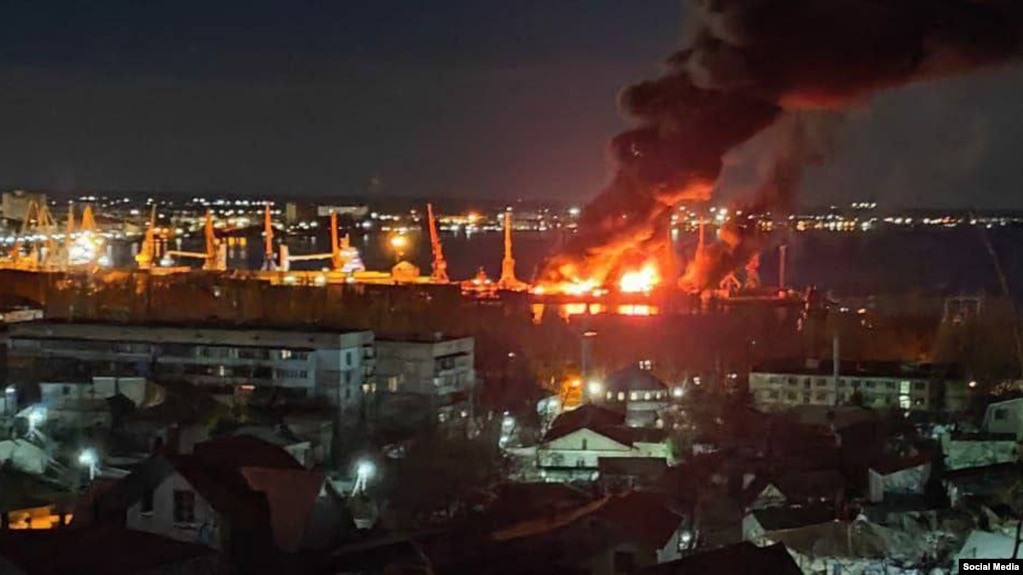Russia is reportedly set to enhance the ‘firepower’ of its large landing ships by arming them with Orlan and ZALA drones.
This initiative is part of the Large Amphibious Assault Ships (BDK) modernization program approved by the Ministry of Defense of the Russian Federation, according to military sources cited by Izvestia.
The modernization program aims to boost the capabilities of Russian Navy landing ships by incorporating Orlan-10 and ZALA unmanned aerial vehicles (UAVs).
These drones will be crucial in adjusting artillery fire, providing support during landings, and enhancing overall operational effectiveness.
As part of the modernization plan, considerations include installing anti-aircraft weapons on the BDK and possibly incorporating Tor anti-aircraft systems in a towed version.
![Russian Ropucha class-landing ship deploying BTR's [1200x795] : r/MilitaryPorn](https://i.redd.it/usn64achidb21.jpg)
However, the final decision on air defense systems remains pending. The comprehensive upgrade also involves strengthening self-defense systems by incorporating additional firing points with Kord machine guns and electronic warfare stations on board the large landing ship.
These enhancements align with the evolving demands of naval operations, emphasizing the adaptability and resilience of Russia’s naval capabilities.
That said, it’s worth noting that Orlan-10 and ZALA unmanned aerial vehicles (UAVs) have already seen extensive deployment in Russia’s operations in Ukraine.
The Orlan-10 UAV multifunctional complex serves various purposes, including aerial and electronic surveillance of subscriber cellular terminals. It can also block GSM cellular communications and distort the GPS navigation field.
The UAV supports convoys, detects targets, and adjusts fire during operations. Operating at altitudes of up to 5,000 meters, it achieves speeds of up to 170 km/h and can stay in the air for an impressive 10 hours.
The Orlan-10 has a substantial range of 140 km, making it an effective tool for surveillance and mission support tasks.
The report, however, did not specify which Zala drone models will be deployed on the large landing ships.
Zala offers a comprehensive series of unmanned aerial vehicles, among which the report highlighted Zala 421-04, Zala 421-08, and 421-16 UAVs.
These drones boast a range of up to 40 km, a payload capacity of 1.5 kg, and a flight duration of up to two and a half hours.
Notably, they are slightly larger than the ZALA 421-20, which operates within a radius of up to 120 km, has an extended flight time of 11 hours, and can carry a payload of up to 50 kg.
The advanced capabilities of these drones include integrated air navigation systems, automatic data interpretation, and onboard laser target designation.
What Drives Moscow To Implement These Measures?
These modernization efforts will likely focus primarily on the Project 775 large landing ships, commonly referred to by their NATO reporting name as the Ropucha class (Polish for Toad).
The Project 775 large landing ships are the backbone of the Russian amphibious fleet. Widely acknowledged as the “workhorses” of the Navy, these vessels have played a pivotal role in various maritime operations.
They have played a crucial role in operations such as the “Syrian Express,” supporting the Russian Aerospace Forces in the Syrian Arab Republic (SAR).
These operations were initiated in response to European countries inspecting bulk carriers delivering goods from Russia to Syria.
Because third countries could not detain warships, large landing ships from the Northern, Black Sea, and Baltic fleets were mobilized to transport goods.

Throughout the ongoing conflict, Ukraine has launched repeated attacks on these pivotal vessels. On August 13, 2023, a Ukrainian assault on the Sevastopol naval base in Crimea resulted in damage to the Russian landing vessel Minsk.
Subsequently, in December 2023, the Russian landing ship Novocherkassk faced destruction as a consequence of Ukrainian strikes on a port in Crimea.
Thus, the decision to upgrade stems from insights gleaned from experiences in the ongoing conflict in Ukraine, highlighting the imperative to strengthen the fire capabilities and protection of landing ships.
The report highlighted that during battles in Mariupol, the UAV-BDK combination proved highly effective, with drones successfully identifying targets and guiding the fire onboard 130-millimeter automatic cannons and multiple launch rocket systems.
Landing ships are more cost-effective compared to frigates. In light of the outcomes of Russia’s special military operation in Ukraine, it has become evident that these ships require reinforcement, including the installation of additional artillery and machine gun weaponry.
Furthermore, drones are now extensively being deployed from the ships’ boards for reconnaissance operations in enemy territory.
Parallel to this, Russia has undertaken several measures to enhance the offensive capabilities of its navy.
In early 2023, Moscow intended to equip all new Russian navy frigates and corvette class vessels with hypersonic Zircon missiles. Nevertheless, the precise timeframe for the implementation of this initiative remains uncertain.
- Contact the author at ashishmichel(at)gmail.com
- Follow EurAsian Times on Google News




